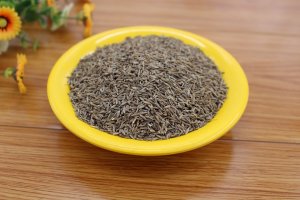What is Cumin?
When it comes to spices, cumin is definitely a favorite among many. With its warm and earthy flavor, it has the power to transform any dish into a culinary masterpiece. But did you know that it is not only delicious, but also packed with health benefits? From aiding in digestion to boosting your immune system, this spice is truly the spice of life. Whether you sprinkle it on your morning eggs, add it to your soups and stews, or use it as a rub for your meats, it is a versatile spice that can be used in countless ways. So, if you’re looking to add some flavor to your life while also reaping the benefits of a healthier diet, look no further than cumin. Join me as we explore the many benefits of this incredible spice and discover why it’s truly a must-have in any kitchen.
History & Background
Cumin has been used for thousands of years in different cultures around the world. It is believed to have originated in the eastern Mediterranean region and was used by the ancient Egyptians, Greeks, and Romans. Furthermore, it was also used in traditional Indian Ayurvedic medicine to aid in digestion and as a natural remedy for respiratory issues.
It was introduced to the Americas by Spanish and Portuguese colonizers and has become a staple in Mexican cuisine. Today, it is widely used in different types of cuisine around the world and is loved for its unique flavor and health benefits.
What Form Does it Come in?
- Whole seed
- Ground powder
- Oil Extract
- Tea
It can be found in several forms. Whole cumin seeds are often used in cooking and can be toasted before being added to a recipe. Ground cumin is a popular spice that is often used in spice blends and can be added directly to a recipe. Cumin oil is used in aromatherapy and can also be consumed in small amounts. Cumin tea is a popular drink in some cultures and is made by steeping the seeds in hot water.
When purchasing cumin, it’s essential to buy it from a reputable source. Ground cumin can quickly lose its flavor, so it’s best to purchase it in small quantities. Whole cumin seeds can be stored in an airtight container for up to a year, while ground cumin should be used within six months for the best flavor.
We have included a link for Ground Cumin Powder, so you will always have some ready to use in your cooking.
100% natural – made from premium cumin seeds.
No preservatives, additives, or fillers. Certified Organic.
Non-GMO, No MSG, and salt free.
14 ounce resealable jar – large pack full of freshness and flavor.
Is Cumin Good for You?
It is not only delicious, but it is also packed with health benefits. One of the most significant benefits of cumin is its ability to aid in digestion. It contains compounds that can stimulate the production of digestive enzymes, which can help to break down food more efficiently. This can lead to less bloating, gas, and constipation.
It is also high in antioxidants, which can help to protect the body from oxidative stress. Oxidative stress can lead to the development of chronic diseases like cancer, diabetes, and heart disease. By consuming foods that are high in antioxidants like cumin, you can help to reduce your risk of developing these diseases.
It also has anti-inflammatory properties, which can help to reduce inflammation in the body. Chronic inflammation has been linked to a variety of health problems, including arthritis, Alzheimer’s disease, and cancer. It is believed by consuming it regularly, you can help to reduce your risk of developing these conditions.
Flavor Profile of Cumin
So what does the cumin flavor profile taste like? Well,it has a warm, earthy, and slightly bitter flavor and is often described as having a smoky or nutty taste. It can add depth and complexity to a dish, and it pairs well with other warm spices like cinnamon, coriander, and turmeric. When used in small amounts, it can add a subtle flavor to a dish, while larger amounts can give it a more pronounced flavor.
It also has a strong aroma that can be detected even before it’s added to a recipe. The scent of it is often described as being slightly sweet and peppery, with a hint of citrus.
Cooking with Cumin
Cumin is a spice that is used in many different types of cuisine. It is a staple in Indian, Mexican, and Middle Eastern dishes, among others. And is often used in spice blends like garam masala and chili powder. It can also be used to flavor meat, vegetables, soups, stews, and even baked goods.
To cook with it, you can either use whole cumin seeds or ground cumin. Whole cumin seeds are best toasted before being added to a recipe, as this helps to release their full flavor. Ground cumin can be added directly to a recipe without toasting.
Cumin can also be used as a dry rub for meat before grilling or roasting. For a simple rub, mix ground cumin with chili powder, brown sugar, salt, and pepper. Rub the mixture onto the meat and let it sit for at least an hour before cooking.
My favorite recipe using Cumin
These cumin-spiced bread rolls are perfect as a side dish or for making sandwiches. I love getting my hands on the dough and kneading it! It helps get rid of some of the tension! I will post a photo the next time I make them – but they don’t last too long once I lift them out of the oven! Enjoy the delicious aroma and flavor of the ground cumin in these homemade rolls!
Cumin Spiced Rolls
Ingredients:
- 3 cups all-purpose flour
- 2 1/4 teaspoons instant yeast
- 1 teaspoon salt
- 2 tablespoons sugar
- 1 tablespoon ground cumin
- 1 cup warm milk
- 1/4 cup melted butter
- 1 egg, beaten (for egg wash)
Cooking instructions:
- In a large mixing bowl, combine the all-purpose flour, instant yeast, salt, sugar, and ground cumin. Mix well.
- Add the warm milk and melted butter to the dry ingredients. Mix until a soft dough forms.
- Transfer the dough to a floured surface and knead for about 5-7 minutes until the dough is smooth and elastic.
- Place the dough in a greased bowl, cover it with a clean kitchen towel, and let it rise in a warm place for about 1 hour or until it doubles in size.
- Preheat your oven to 375°F (190°C).
- Punch down the risen dough and divide it into equal-sized portions. Shape each portion into a small round roll and place them on a greased baking sheet, leaving some space between them.
- Cover the rolls with a clean kitchen towel and let them rise for another 20-30 minutes.
- Brush the rolls with beaten egg wash to give them a shiny glaze.
- Bake in the preheated oven for 15-20 minutes or until the rolls are golden brown.
- Remove from the oven and let them cool on a wire rack.

Common uses for cumin
It is a spice that has been used for thousands of years in different cultures around the world. Apart from cooking, it has also been used for medicinal purposes. Cumin oil is used in aromatherapy to treat insomnia, anxiety, and respiratory problems. Research has shown that cumin oil may also have anti-inflammatory properties that can help with skin conditions like eczema and psoriasis.
In some cultures, it is also used as a natural remedy for digestive issues like bloating, constipation, and diarrhea. Cumin tea is a popular drink in some countries and is believed to help with digestion. It is also used in traditional medicine to help with menstrual cramps, as it is believed to have a calming effect on the uterus.
Cumin is also used in cosmetic products like perfumes and skincare products. Due to its antibacterial properties, it can help with acne and other skin issues. Overall, it is a versatile spice that has many uses beyond just cooking.
Alternatives to Cumin
If you’re unable to find cumin or are looking for a substitute, there are several alternatives that you can use. Coriander has a similar flavor profile to cumin and can be used as a substitute in most recipes. Caraway seeds and fennel seeds can also be used in place of cumin, although they have a slightly different flavor.
For a more complex flavor profile, you can use a combination of spices like cinnamon, coriander, and turmeric. This can help to replicate the warm and earthy flavor of cumin.
Have a look at our substitutes section for ideas on what you can use in place of cumin.
Conclusion
Cumin is a spice that is both delicious and packed with health benefits. It has been used for thousands of years in different cultures around the world and is now a staple in many different types of cuisine. Whether you’re using it to flavor meat, vegetables, soups, or stews, it is a versatile spice that can add depth and complexity to any dish.
From aiding in digestion to reducing inflammation in the body, it is truly the spice of life. So, the next time you’re in the kitchen, don’t forget to reach for the cumin. Your taste buds and your health will thank you.
Table of Contents
- What is Cumin?
- History & Background
- What Form Does it Come in?
- We have included a link for Ground Cumin Powder, so you will always have some ready to use in your cooking.
- Is Cumin Good for You?
- Flavor Profile of Cumin
- Cooking with Cumin
- My favorite recipe using Cumin
- Common uses for cumin
- Alternatives to Cumin
- Conclusion

